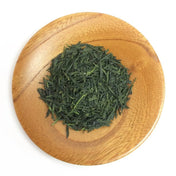Hello, it's summer time! I hope you are all enjoying the longer days and more light, enjoying the flowers and their pollinators around this time of year.
In my last post, I highlighted the great sannen bancha tea which perhaps can be thought of more as a winter tea. Although, I personally find it to be wonderful during other seasons, too. But today, since we are welcoming the hot summer days to come, I will shine light on mugicha (barley tea), which is the classic summer drink indispensable in households throughout Japan. Growing up, I remember always having mugicha ready to drink in the refrigerator at home. So, in this post, I will touch on what mugicha is, relate its history, and share with you how mugicha consumption has changed over time.
Mugicha, roasted barley tea
Mugicha simply means barley tea in Japanese. Barley falls in the wheat family but is different from what we use to make bread, pasta, udon, or pancakes. Barley is a type of grain that is used as raw material to make products such as beer, miso and soy sauce. Often, we are not familiar with eating it as a grain. Nonetheless, for much of the history of civilization, barley was a primary staple food as it is more resilient to low temperatures and drought. Even in Japan, where rice is thought of as the staple, people actually ate barley much more than rice before war-time.
 Barley and rye look similar as both have little spiky hairs, called awns extending from their seeds while wheat does not. The left photo shows a barley field in Japan (photo by Nabeshima Meicha) and the right photo shows a mixed rye and wheat field we recently visited in France that is harvested for bread (photo by Jimmy Burridge).
Barley and rye look similar as both have little spiky hairs, called awns extending from their seeds while wheat does not. The left photo shows a barley field in Japan (photo by Nabeshima Meicha) and the right photo shows a mixed rye and wheat field we recently visited in France that is harvested for bread (photo by Jimmy Burridge).
Mugicha is made by roasting and then boiling the barley. In comparison to firing tea directly in pans (like the kamairi method), the traditional method was to employ sand-roasting, a process which takes time and effort. By heating the sand, it was possible to slowly roast the barley in kama to obtain a rich aroma and to prevent it from being scorched. With sand roasting, the fire wouldn’t become too strong, therefore preserving the umami and sweetness of the tea. Nowadays, it can be quite rare to find mugicha made through this method but it is possible!
 Shop Nabeshima Hida Mugicha Barley Tea (bulk) 飛騨むぎ茶
Shop Nabeshima Hida Mugicha Barley Tea (bulk) 飛騨むぎ茶
 Roasted barley; photo by Nabeshima Meicha.
Roasted barley; photo by Nabeshima Meicha.
Brief history of mugicha
In Japan, roasting barley and making it into a drink has been a custom since the Heian period (794-1185). In that sense, mugicha spread throughout Japan earlier than green tea, and it is said that the nobles and military commanders from this period enjoyed it as a drink called “mugi-kogashi” (麦焦がし; scorched barley). They would drink a mixture of dry roasted barley flour and sugar dissolved in hot water or alcohol. Yes, mugicha was first drunk hot and to my surprise, even with some added sugar!
It was not until the end of the Edo period (1603-1868) when barley tea became a popular, casual drink for townspeople. During this time, it was enjoyed in "barley tea shops (Mugiyu-ten; 麦湯店)". As a note, the mugiyu kanji indicates that it is a hot drink and indicating that during this time it was still mainly served hot. In the Meiji era (1868-1912), mugicha became even more widespread in ordinary households and cafes. Finally, the mugicha revolution happened in 1963. The background? This was the year before the Tokyo Olympics and the very first mugicha tea bags were released by Hitachiya-Honpo Incorporated. This more convenient way of making tea, along with the widespread adoption of refrigerators in Japanese households catalyzed the popularity of cold mugicha tea. Two years later, in 1965, Ishigaki Foods launched mugicha tea bags that could just be made by steeping directly in water, in other words, not boiled. Add to this that barley is harvested in early summer and we have our explanation of how mugicha became a summer staple.  Cup of cold Mugicha; photo by Nabeshima Meicha.
Cup of cold Mugicha; photo by Nabeshima Meicha.
Mugicha during the pandemic
While mugicha has been a summer staple in Japan for over 100 years, the Japan Food Journal recently reported the global pandemic has increased the consumption of mugicha tea bags. Because people have been spending more time at home (and making fewer trips to the convenience stores to buy bottled mugicha), the mugicha tea bag business has been doing relatively well in the market. Moreover, although mugicha has a strong impression in Japan to be a summer drink, it seems now that it is also being drunk in the autumn and fall. The Japanese seem to have a familiarity with this drink and because it is caffeine free, many households with children as well as elders are finding it to be a drink that is compatible for all. And with the rise in environmental consciousness, people are carrying around mugicha in their own bottles (what we refer to as “my bottle” in Japan). Lastly, although it is uncertain whether mugicha tea bags will continue to be a hit, people are also starting to experiment cooking and baking with mugicha! For instance, bakers have been creative to make a mugicha pound cake instead of a black tea based one. And, instead of a green tea base to make ochazuke, mugicha can be a nice option, perhaps, especially in the summer when it can be enjoyed cold.
I hope you enjoyed reading and learning about mugicha as much as I did researching its history! Try to make time to enjoy a nice cold mugicha this summer, perhaps relaxing, eating a slice of watermelon, and listening to the summer cicadas... Oh, and here is a fire lily as a summer solstice greeting. Cheers to summer and mugicha!
 Lilium bulbiferum; photo by Moé Kishida.
Lilium bulbiferum; photo by Moé Kishida.
Related blog posts about mugicha:
- To learn more about mugicha, read an earlier post written by Victoria Garafola (September 2018).
Feature image by Nabeshima Meicha


